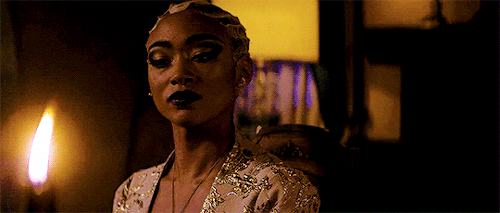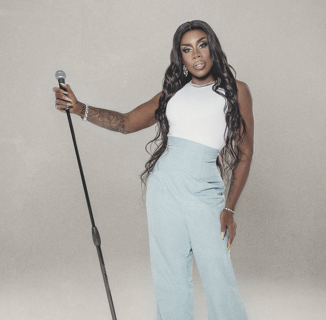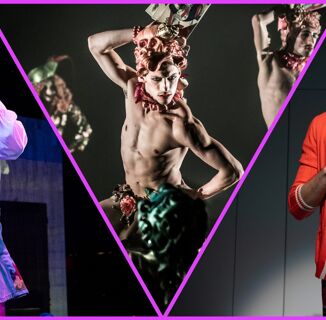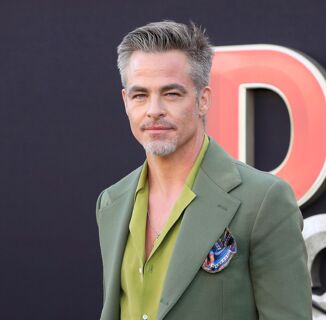The Chilling Adventures of Sabrina might bear the name of its protagonist, Sabrina Spellman, but LGBTQ viewers know who the series’ true star is: the queer, bi-racial antagonist, Prudence Night. It’s as though the show’s writers sat down in a room and vowed to give the gays everything we could want in a powerful, queer villain.
Prudence (Tatiana Gabrielle) is the head witch at the Academy of Unseen Arts, a boarding school for witches and warlocks. She also leads a trio of powerful orphaned witches called the “Weird Sisters,” which includes Dorcas and Agatha, Prudence’s illegitimate sisters and her loyal followers. We are introduced to the Weird Sisters when they astral project into the woods to curse Sabrina, who is half-witch, half-human. The Sisters’ curse is meant to keep Sabrina from undergoing her dark baptism and attending their academy.
“We don’t want half-breed witches at our academy,” Prudence says before hexing her. “Half-breed witches are an abomination.”

Their feud is deeper than that. Prudence is devoted to serving Satan, while Sabrina is devoted to defeating him. Prudence is offended by Sabrina’s blatant disrespect toward her God.
Prudence is legitimately bisexual—not the film industry’s queer-coded definition of bisexual, all-too-often portrayed as a flirtatious woman who appreciates a beautiful woman but is too afraid to cross the line with them, and equally scared to upset anti-queer viewers. Queer-coding is a form of queerbaiting; queerbaiting is basically the equivalent of shitting in a can and calling it chili. A writer can create a character then call them queer. However, if that character is not allowed space to showcase their queerness, they’re basically shit inside of a can with a label that reads “chili.” *Cough* Batman’s Harley Quinn. *Cough* Xena: Warrior Princess’ Xena and Gabrielle.
Prudence is a sexually liberated queer woman who receives sexual gratification from torturing boys and having wild group sex with her illegitimate (non-blood related) witch sisters. Also, she doesn’t mind having sex with her sworn enemy’s cousin, Ambrose, who is also a queer person of color.

More often than not, animated villains like The Little Mermaid’s Ursula, The Lion King’s Scar, and The Powerpuff Girls’ HIM are queer-coded, portrayed as sexually ambiguous. We will never see these characters holding a rainbow flag in solidarity with the queer community. We will never see these characters kiss or hold hands with the same sex. These are individuals who simply endear to queer audiences because they’re sassy, flamboyant, and because of the LGBTQ community’s desperation to have even a splash of gay in our favorite childhood movies. These villains are also depicted as people of color, which would lead one to believe that film-writers don’t deem anyone who isn’t white interesting enough to be the protagonist; they must believe that people of color make better foils.
Let’s dig in a little deeper. Why do people assume that Ursula is a queer woman of color when her character is inspired by Harris Glenn Milstead, a famous white drag queen whose stage name was Divine and both her voice actresses are white women (Pat Carroll and Karen Black). HIM is a bitchy lobster who wears thigh-high boots and is red. Why do people assume that he is based on a person of color? People might argue that it is because Ursula and HIM are flamboyant and vicious, but what does that say about ugly stereotypes and our eagerness to accept them?
Unlike Ursula and HIM, Prudence is one of the few queer villains of color we can celebrate. We don’t have to assume that Prudence is a queer woman of color by dissecting her characteristics. We can see that she’s Black, and she shows us that she’s queer. Initially, I raised an eyebrow at Prudence’s character, afraid that The Chilling Adventures of Sabrina would fail us, queer people, as many other shows did—by depicting one queer person of color who is simply evil. But this isn’t the case: we also got Ambrose, a pansexual man of color. He is also Sabrina’s cousin, and he’s depicted as good—minus the fact that he’s under house arrest for attempting to blow up the Vatican. OK! There’s still work to do in terms of queer people of color’s representation in films, but we’re getting there…
Queer people like myself grew sick of those typical cishet happy endings, so we settled for those queer-coded characters who gave the protagonist hell from the beginning to the end of the film. Granted, those movies were written when people bristled at the thought of queer representation in mainstream media. However, as queer people are still fighting for visibility, nothing is more offensive than a queer-coded or ‘allegedly queer’ character.
This is why queer people were outraged when Solo: A Star Wars Story co-writer, Jonathan Kasdan, confirmed to HuffPost that Lando Calrissian, a character played by Donald Glover, is pansexual. “There’s a fluidity to Donald and Billy Dee’s [portrayal of Lando’s] sexuality,” Kasdan said. “He doesn’t make any hard and fast rules. I think it’s fun. I don’t know where it will go.”
We know where it will go—the same place Finn and Poe’s fake queerbait of a relationship went on Star Wars: The Force Awakens; absolutely nowhere.
Harry Potter writer J.K Rowling, too, came under fire after revealing that Professor Albus Dumbledore, the deceased headmaster of Hogwarts, was gay. Dumbledore, unlike many queer-coded characters, did not have the opportunity to showcase his queerness in any way or form in any of the books or movies. I’m not suggesting that he had to turn the dining hall into an underground ballroom and start voguing in a rainbow robe. I’m just saying that Rowling should have had a better explanation than “Maybe because gay people just look like… people?” after a fan told her that she couldn’t see how Dumbledore’s character was gay.
No one could see how Dumbledore was gay. That’s the problem with cishet writers who are desperate to appeal to queer audiences: they create characters then call them queer, without giving them an opportunity to walk in their queerness.
Prudence, however, breaks the monotony. She doesn’t just endear to queer people because she embodies sassy or flamboyant characteristics; she’s an actual queer person. She does exactly what all queer characters should do: show, don’t tell. Her other attributes are just a plus.
Also, let’s observe some other characters queer people celebrate who are meant to be villainous in their respective on-screen stories: Mean Girls’ Head Plastic Regina George, Once Upon A Time’s evil queen Regina Mills, and The Devil Wears Prada’s HBIC Miranda Priestly. Queer people love them not just because of how mean or fierce they are, but because these characters are multilayered; we don’t know what we’re going to get from them. However, we do know that they’re going to challenge the protagonist who already has the odds stacked in their favor. We do know that they’re going to steal the show whenever their character makes an appearance. They are unpredictable, and we sit at the edge of our seats wondering what their character will do or say. We love their dark side, and we’re excited to see their softer side—if they have one.
Prudence is multilayered, too. Read one way, she acts only out of self-interest and at Father Blackwood’s behest. Father Blackwood is the dean at the Academy of Unseen Arts, the High Priest at the Church of Night, and is the devil’s right hand. We later find out that he is also Prudence’s biological father. At first, she believed that he only treated her like a daughter because he was “a charitable man,” but he reveals this secret after eating a slice of truth-cake, which temporarily renders someone incapable of telling a lie.
We saw this when Father Blackwood tasks Prudence with “harrowing” Sabrina. Harrowing is a tradition at the Academy of Unseen Arts, where stronger witches prank the newbie witches. Sometimes, these pranks end tragically. She displays her darkest side when she attempts to hang Sabrina. In later episodes, she shows her softer side after aiding Sabrina in murdering Agatha. She says she only helped kill Agatha because she knew that she would be resurrected. When Agatha becomes gravely ill due to the spell, Prudence suggests that she is willing to do anything to save her sister—a clear sign that underneath her darkness, there’s some light.

This is the type of queer character that I have been waiting for—someone who is black and refuses to come second place to some pretty little white girl. As an aspiring fiction writer, Prudence’s character allows me to step back, observe my black and queer identity, then begin to build a character that queer, black people can celebrate—just as we are celebrating Prudence’s character:
Ambrose and Prudence my bisexual legends
— liv (@livanthelife) November 2, 2018
prudence, a bisexual queen!!!!
— jo (@sugarhye) October 30, 2018
Many LGBTQ people are rooting for Prudence’s character development, simply because there aren’t enough good examples of what a queer villain of color should be. And whether she joins the light side or the dark side, we are hoping that she continues to remain the stylish queer icon that always steals the show, which we are hoping she will continue to do for the foreseeable future, as Netflix has picked up the show for three additional seasons, including a bonus Christmas episode available now.
Help make sure LGBTQ+ stories are being told...
We can't rely on mainstream media to tell our stories. That's why we don't lock our articles behind a paywall. Will you support our mission with a contribution today?
Cancel anytime · Proudly LGBTQ+ owned and operated
Read More in Culture
The Latest on INTO
Subscribe to get a twice-weekly dose of queer news, updates, and insights from the INTO team.
in Your Inbox













